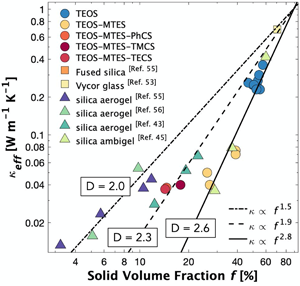Crossref Citations
This article has been cited by the following publications. This list is generated based on data provided by
Crossref.
Merillas, Beatriz
Martín-de León, Judith
Villafañe, Fernando
and
Rodríguez-Pérez, Miguel A.
2021.
Transparent Polyisocyanurate-Polyurethane-Based Aerogels: Key Aspects on the Synthesis and Their Porous Structures.
ACS Applied Polymer Materials,
Vol. 3,
Issue. 9,
p.
4607.
Qin, Zihao
Li, Man
Flohn, Jessica
and
Hu, Yongjie
2021.
Thermal management materials for energy-efficient and sustainable future buildings.
Chemical Communications,
Vol. 57,
Issue. 92,
p.
12236.
An, Lu
Li, Zheng
Guo, Zipeng
Hu, Yong
Huang, Yulong
Armstrong, Jason N.
Zhou, Chi
and
Ren, Shenqiang
2022.
Transparent thermal insulation ceramic aerogel materials for solar thermal conversion.
Nanoscale Advances,
Vol. 4,
Issue. 20,
p.
4291.
Wiederhorn, Sheldon M.
and
Clarke, David R.
2022.
Architectural Glass.
Annual Review of Materials Research,
Vol. 52,
Issue. 1,
p.
561.
Marszewski, Michal
King, Sophia C.
Galy, Tiphaine
Kashanchi, Glareh N.
Dashti, Ali
Yan, Yan
Li, Man
Butts, Danielle M.
McNeil, Patricia E.
Lan, Esther
Dunn, Bruce
Hu, Yongjie
Tolbert, Sarah H.
and
Pilon, Laurent
2022.
Transparent silica aerogel slabs synthesized from nanoparticle colloidal suspensions at near ambient conditions on omniphobic liquid substrates.
Journal of Colloid and Interface Science,
Vol. 606,
Issue. ,
p.
884.
Galy, Tiphaine
and
Pilon, Laurent
2022.
Dependent scattering effects in aggregates with touching or overlapping non-absorbing spherical particles.
Journal of Quantitative Spectroscopy and Radiative Transfer,
Vol. 278,
Issue. ,
p.
108018.
McNeil, Patricia
Guillemin, Thibaud
Fox, Maggie
Le Bideau, Jean
and
Dunn, Bruce
2022.
Characterization of Fragility in Silica-Based Ionogels.
The Journal of Physical Chemistry C,
Vol. 126,
Issue. 43,
p.
18528.
Li, Man
Dai, Lingyun
and
Hu, Yongjie
2022.
Machine Learning for Harnessing Thermal Energy: From Materials Discovery to System Optimization.
ACS Energy Letters,
Vol. 7,
Issue. 10,
p.
3204.
Lee, Sung Yun
Cho, Do Hyung
Song, Sung Chan
Shin, Jaeyong
Hwang, Junha
Park, Eunyoung
Lee, Su Yong
Kim, Seongseop
Lee, Jinwoo
and
Song, Changyong
2023.
Nanoscale Three-Dimensional Network Structure of a Mesoporous Particle Unveiled via Adaptive Multidistance Coherent X-ray Tomography.
ACS Nano,
Vol. 17,
Issue. 22,
p.
22488.
Kashanchi, Glareh N.
King, Sophia C.
Ju, Susan E.
Dashti, Ali
Martinez, Ricardo
Lin, Yu-Keng
Wall, Vivian
McNeil, Patricia E.
Marszewski, Michal
Pilon, Laurent
and
Tolbert, Sarah H.
2023.
Using small angle x-ray scattering to examine the aggregation mechanism in silica nanoparticle-based ambigels for improved optical clarity.
The Journal of Chemical Physics,
Vol. 158,
Issue. 3,
Yalcin, Refet Ali
McNeil, Patricia E.
Kashanchi, Glareh N.
Martinez, Ricardo
Tolbert, Sarah H.
Dunn, Bruce S.
and
Pilon, Laurent
2023.
DEPENDENT SCATTERING IN SILICA AMBIGEL MONOLITHS - EXPERIMENTS AND SIMULATIONS
.
p.
211.
Olla, Chiara
and
Carbonaro, Carlo Maria
2024.
The void side of silica: surveying optical properties and applications of mesoporous silica.
Journal of Physics: Condensed Matter,
Vol. 36,
Issue. 25,
p.
253002.
